That night we spent in Antarctica we slept for only a couple of hours and then already at 4 am we were up. Still, all we did then was to take coffee or tea, since it snowed until 5 am and we had to wait for the snow to stop. Actually, there is a proper question whether it was real snow or the air was just freezing. Namely, Antarctica is the driest part of the planet Earth. This is in a way unexpected taking into consideration the enormous quantity of snow that lies over the ground there.
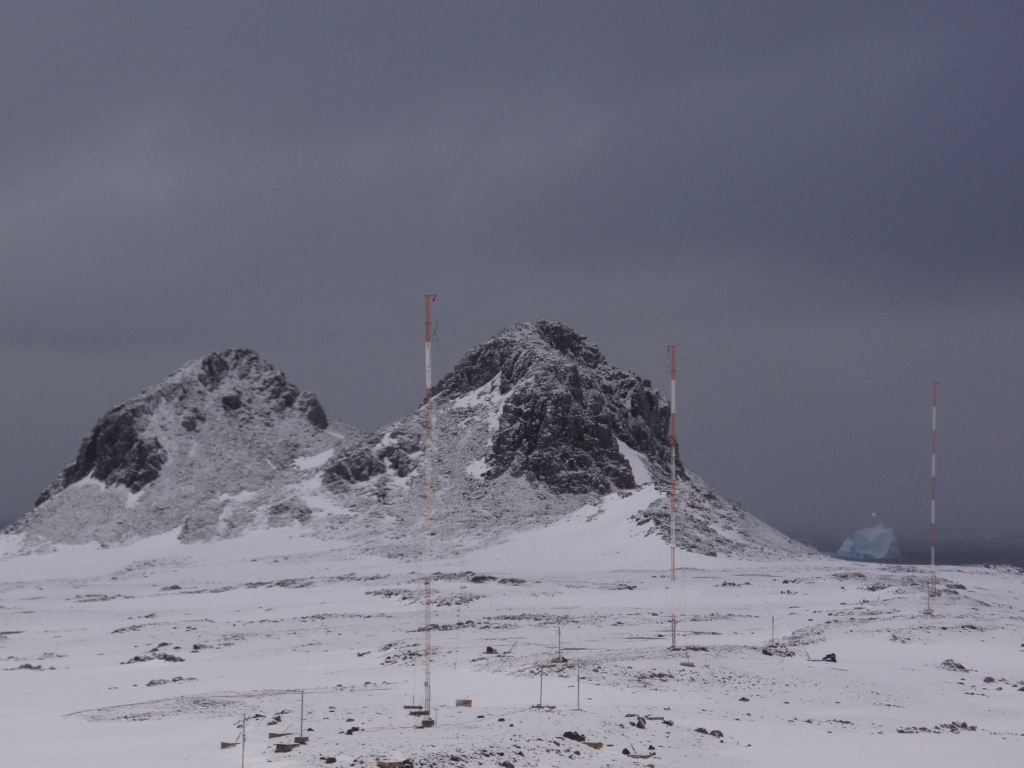 Antarctica’s landscape, with an iceberg in the distance on the right-hand side
Antarctica’s landscape, with an iceberg in the distance on the right-hand side
When the blizzard stopped and we finished our warm beverages, we went for a walk, well dressed and properly equipped. To be precise, along with the clothes we had on us, we also got skiing goggles and rubber boots that we put on over our shoes. It was early in the morning and it was cold. As if we were in Antarctica.
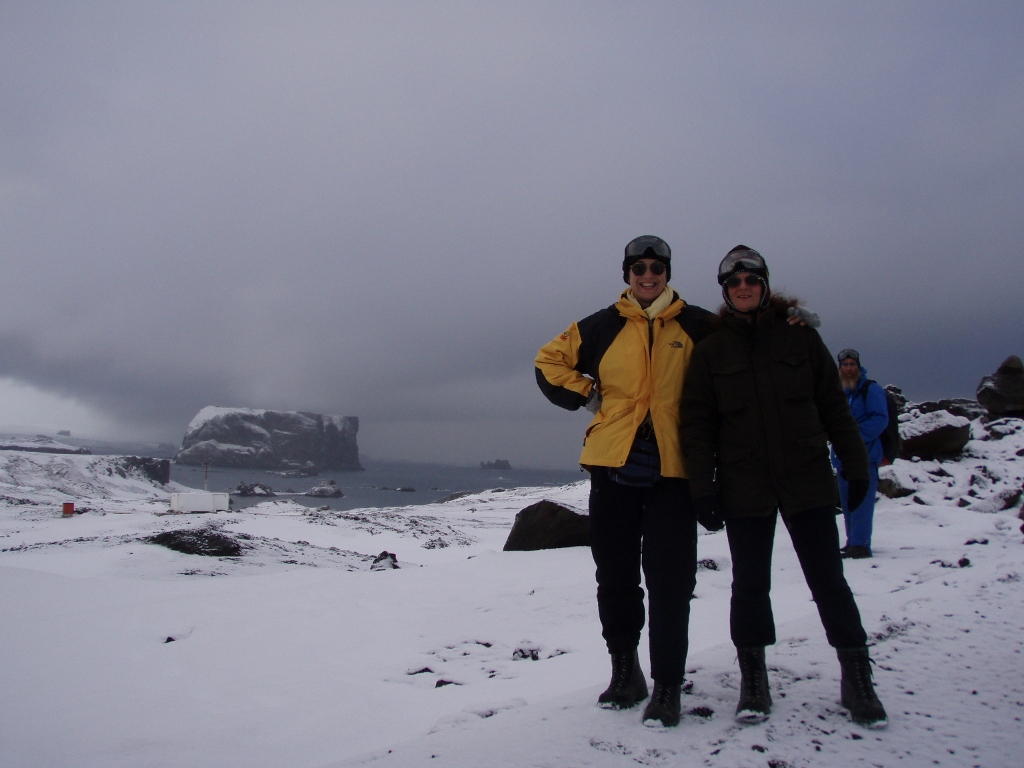 Ready for the walk. Alejo, the guide, is behind us
Ready for the walk. Alejo, the guide, is behind us
The goal was to reach the shore on the opposite side from the one where the bases are in order to watch elephant seals, but the path we followed took us with absolutely no malevolent desire on our part very near to a nest of Antarctic turns. They got furious! Flying around our heads they let us have it. I was even pecked on my head by one of them and then the guide told us to turn the ski poles we used to help us walk up-side-down and lift them in order to prevent the turns from picking on us. Still, we passed that section soon and the mom and dad Antarctic turn could calm down.
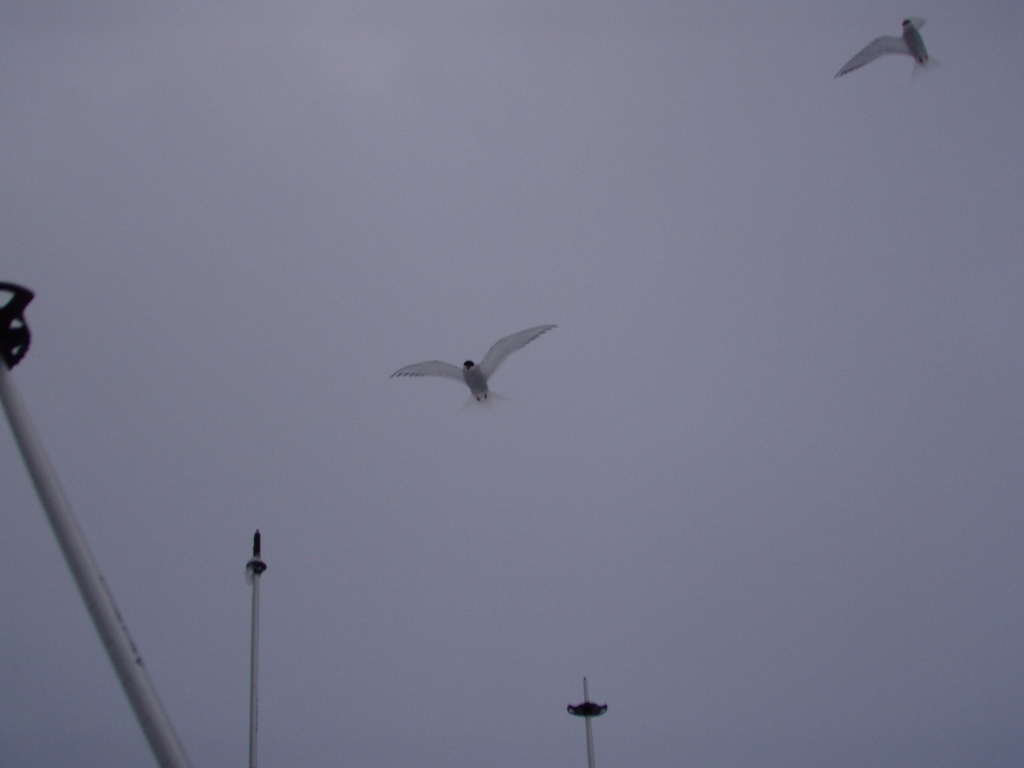 Angry Antarctic turns
Angry Antarctic turns
As opposed to the turns, the skuas we saw along the way were quite composed. While one bird was just calmly standing on the ground, the other one of the same species was even calmer while sitting on the nest, completely cool and unmolested by the fact that we were passing by just a few metres away.
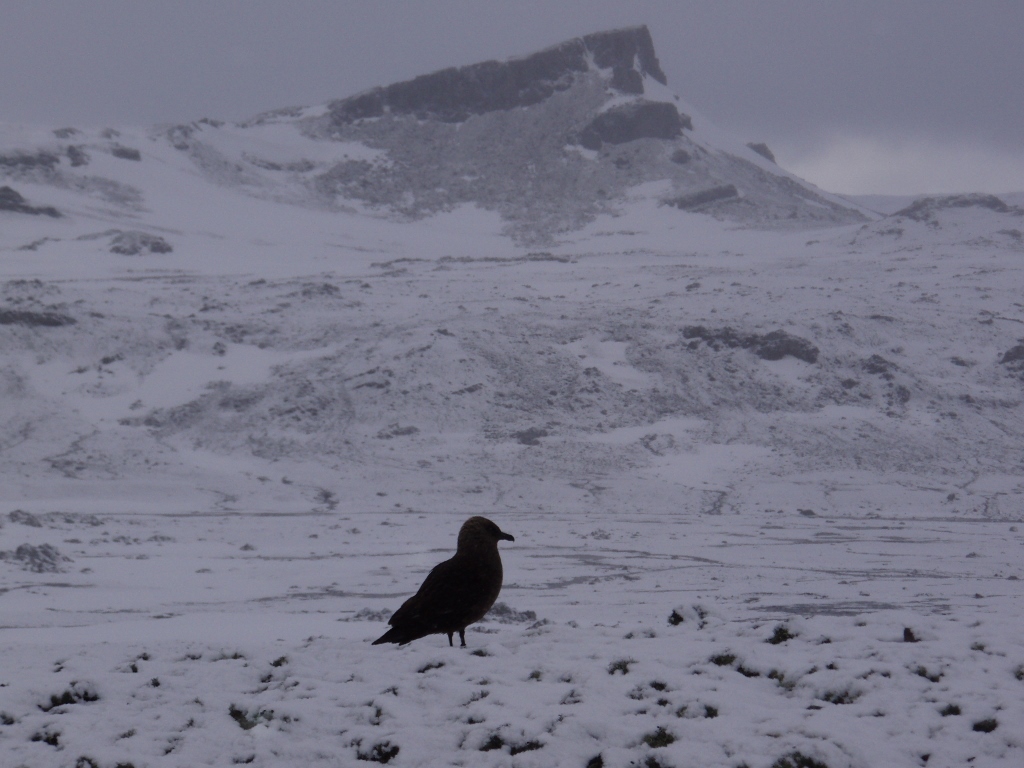 A skua standing guard
A skua standing guard
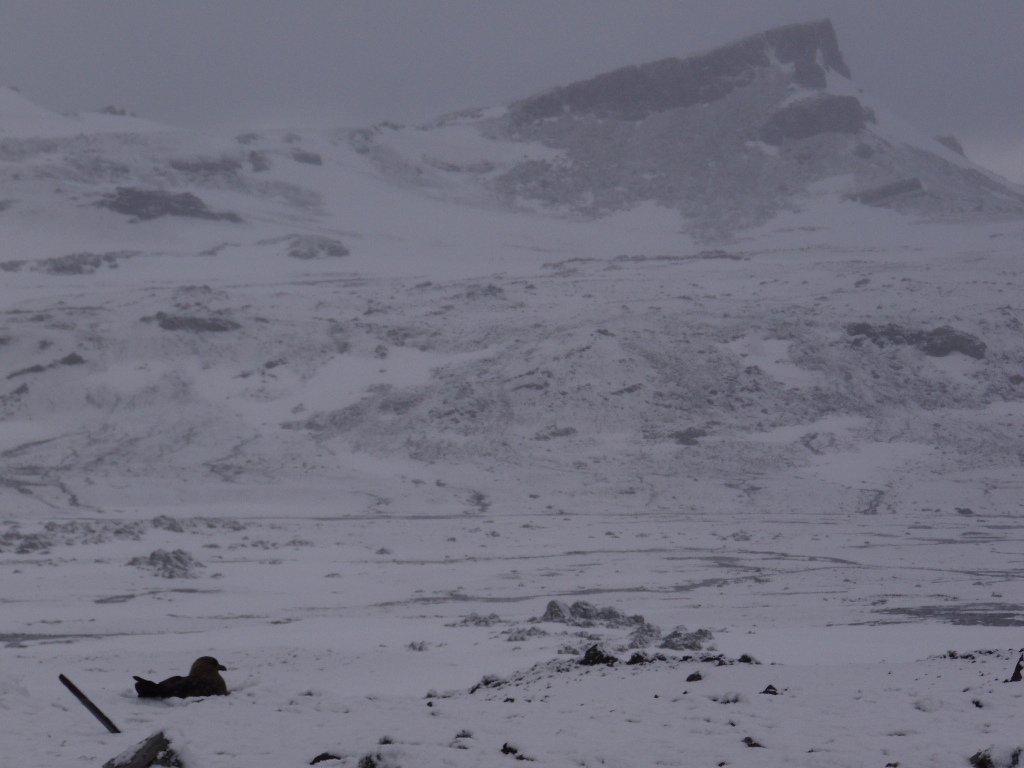 A skua sitting on the nest
A skua sitting on the nest
Thus we eventually reached a bay and from the elevation we were on we saw a couple of elephant seals lying on the beach. We also saw smaller icebergs. In addition to the black sand and white snow, there were also some reddish-orange algae which the sea had washed ashore.
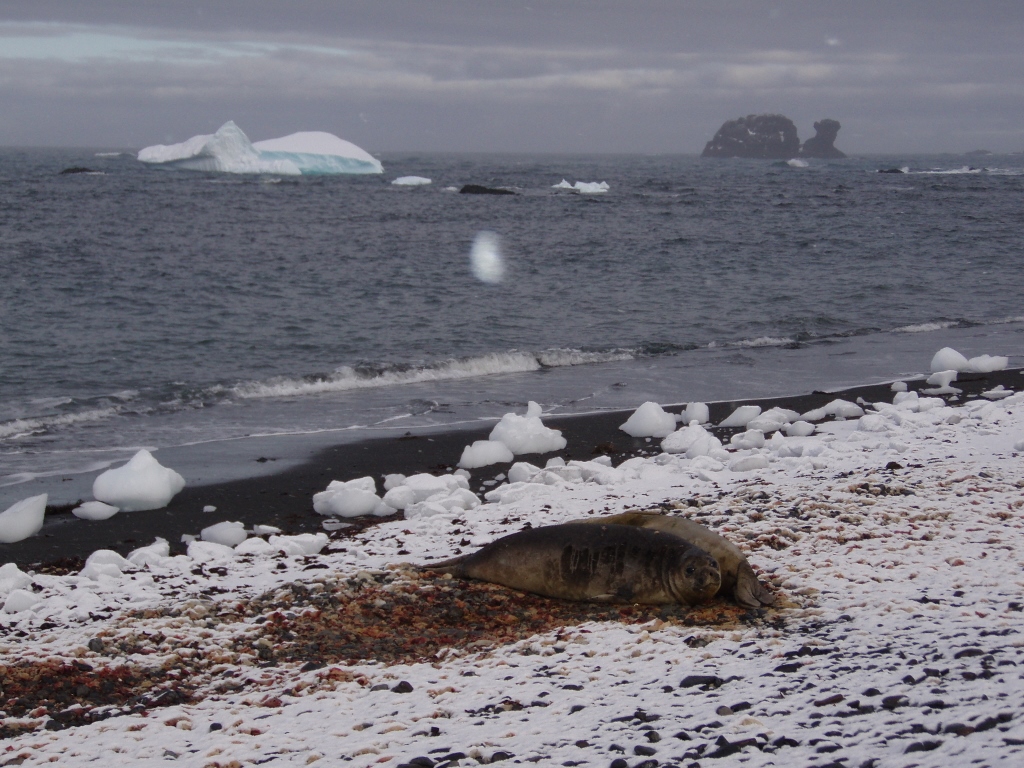 Elephant seals
Elephant seals
I collect samples of sand from beaches and other locations, but when I asked our guide if it would be ok to take a small quantity from there, he said it wouldn’t, so I didn’t take any. Our guide, Alejo, is completely infatuated with Antarctica, such as it is – almost untouched, in addition to which some international conventions prohibit taking and taking away any samples from Antarctica, except for scientific purposes and I respect that.
Although there were still a few snowflakes flying around us (the white spot in the upper photo), we even started to get a little sunshine here. On the surrounding rocks we could see some light patches and these were lichen that somehow manage to survive in such an inhospitable place as these rocks exposed to the elements are.
From a smaller section of the beach, we went over a low elevation and down to a longer beach, but along our way we passed by a crabeater seal and a slightly darker Weddell seal, which were just lying there in the snow!
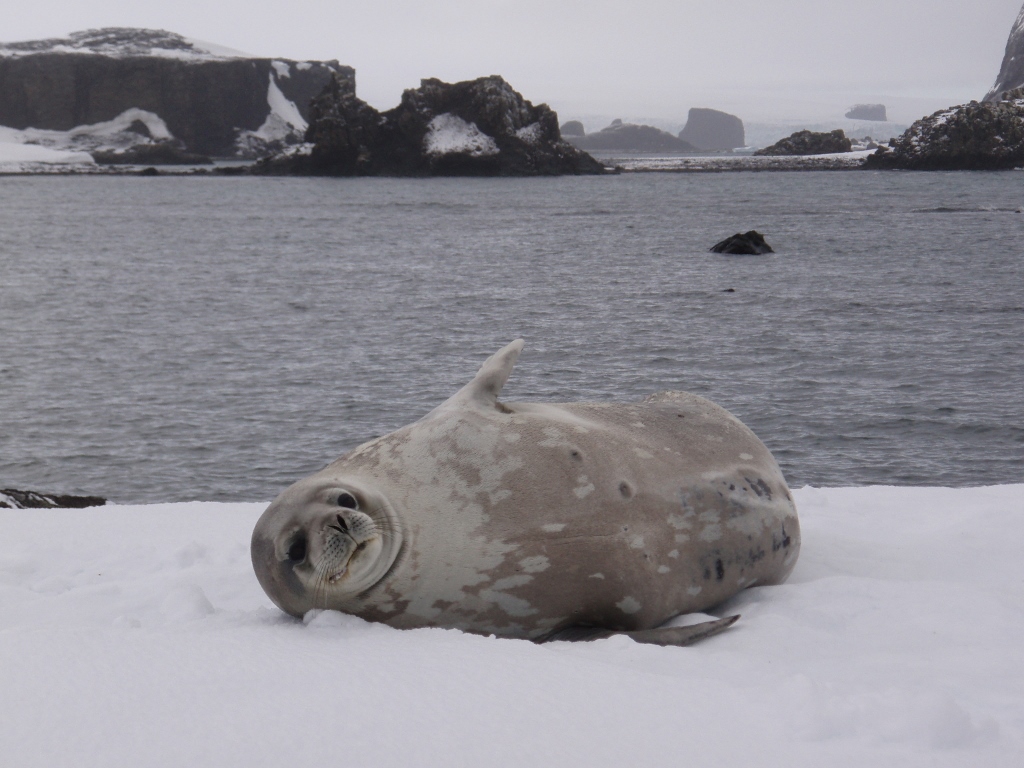 Crabeater seal
Crabeater seal
Then we got to the larger section of the shore and there were also more elephant seals there. We could not quite get too close to them, since they voiced out their objection and one even went into the water while we were standing there. A couple of bulls we saw there were still young and they didn’t have the proboscis (the “trunk”) typical of older individuals. Female elephant seals (cows) do not have this pronounced snout, regardless of their age, and they are also smaller than the males.
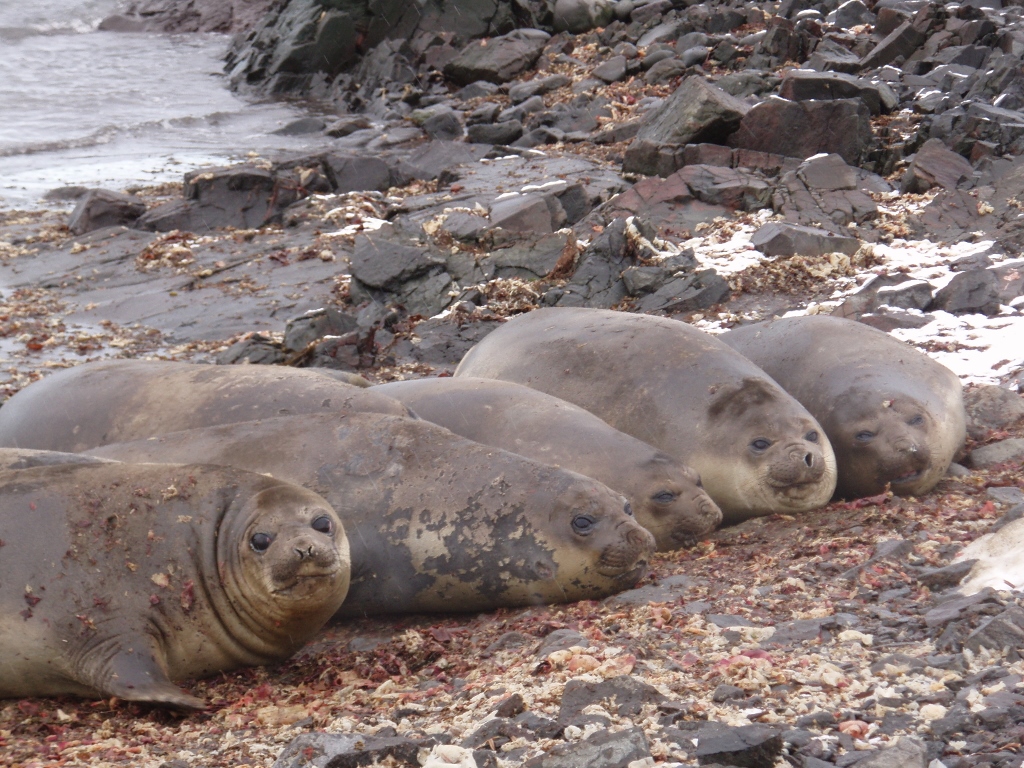 Elephant seals
Elephant seals
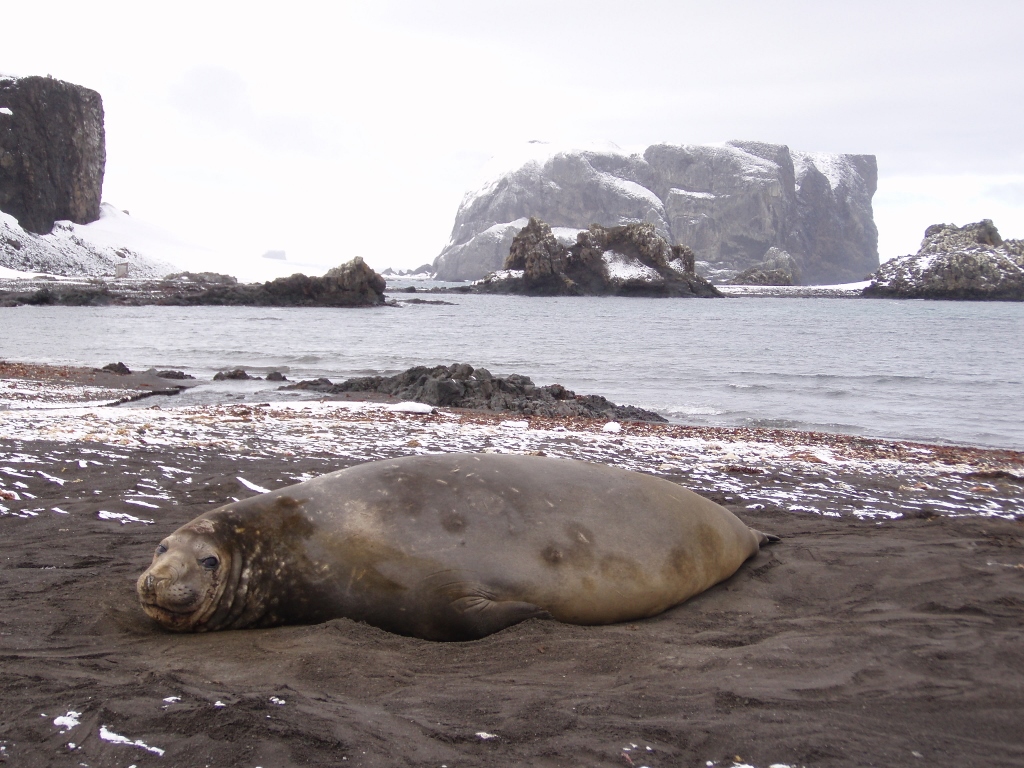 An elephant seal
An elephant seal
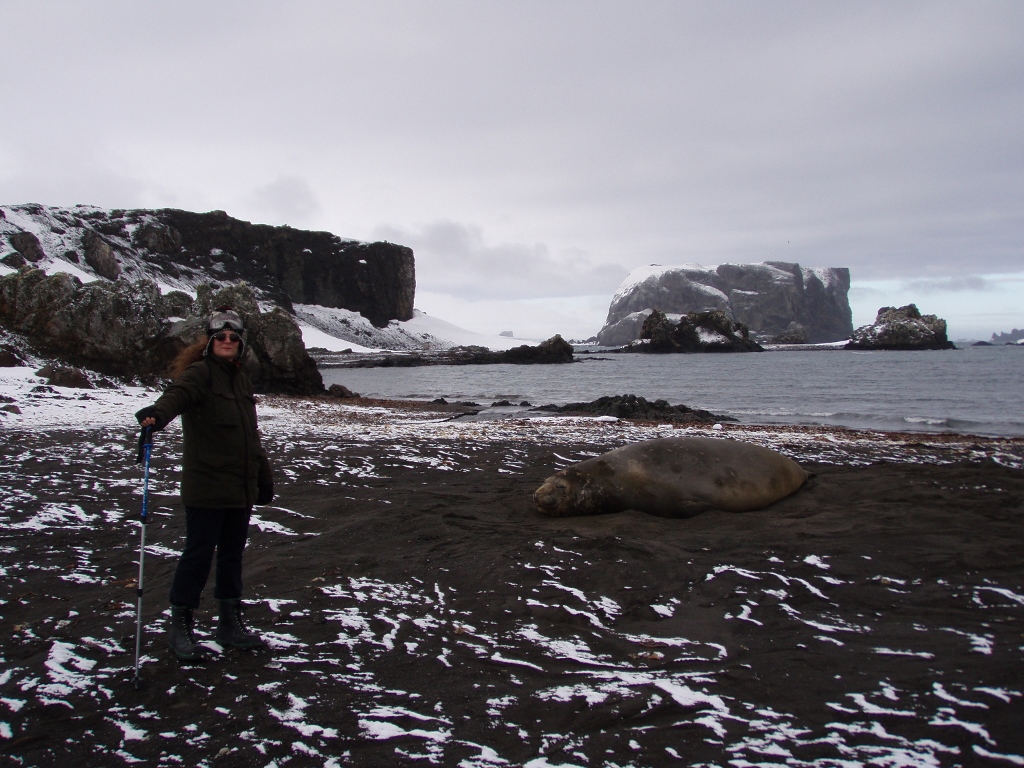 In order to get an idea about the size of the elephant seal, Sneza is approx. 175 cm tall
In order to get an idea about the size of the elephant seal, Sneza is approx. 175 cm tall
After the walk on the beach, we had to return to have breakfast, so we first headed in the direction of the Chilean base. We went back following another way in comparison to the one we used earlier to reach the shore and since it was already day time and the temperature was a little above freezing this meant that on a couple of occasions we had to walk in shallow mud and jump over small streams created by the thawing snow. Still, a couple of times we had to go through the rather deep snow. Alejo was the one to cut through the snow and we only walked behind him following his footsteps.
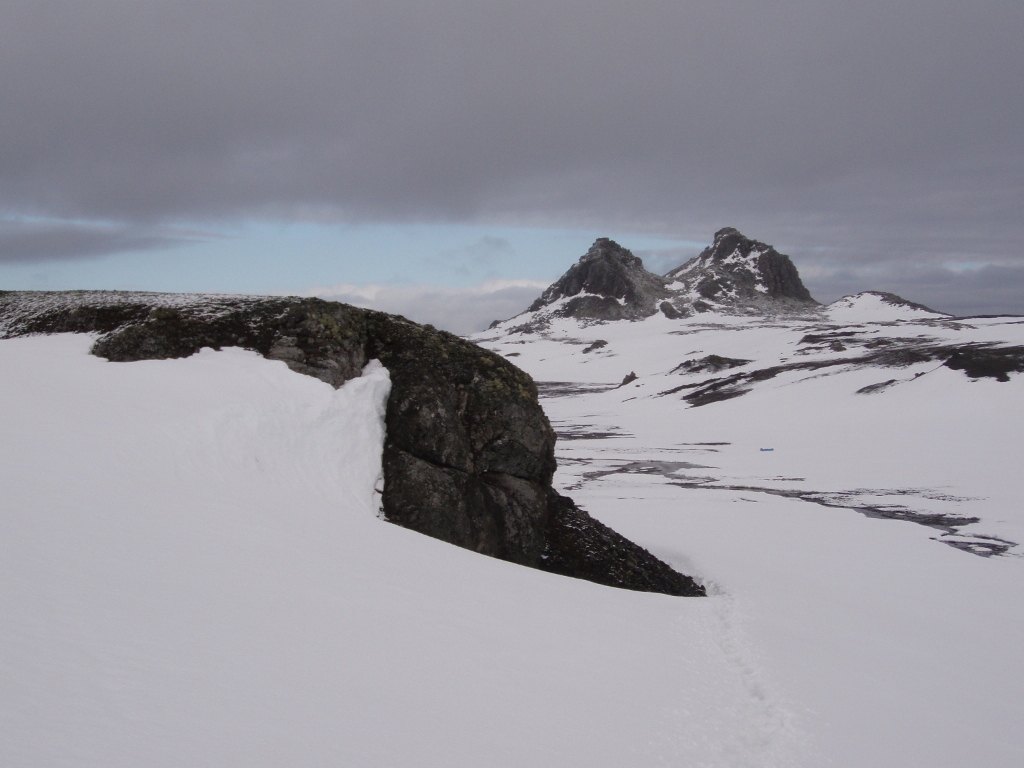 Walking in Antarctica, to the right and down there is a visible path in the snow we made
Walking in Antarctica, to the right and down there is a visible path in the snow we made
And so we reached the Chilean base – Presidente Eduardo Frei Station – and that is a proper settlement. In 1984, the first Chilean baby in Antarctica was born here. By the way, coming and working here is a very attractive thing for Chileans. The salaries are significantly higher than on the continent and thus the absence of vegetation and warm sun are no longer that important.
In the settlement we also saw the Chilean church, but in terms of architectural creativity this was a far cry from the Russian one – a slightly bigger metal container painted in blue with yellow and brownish details. Within the base, there is also a monument dedicated to the Antarctic Treaty.
Antarctica is a large and distant continent where people do not live naturally. Because of these large expanses of land that are far away from the main events linked to human activities, many have a desire to take hold of and use in different, not always nice and peaceful ways, if not the entire continent than at least some of its parts. In order to prevent this as much as feasible, the Antarctic Treaty was signed in 1959 and became effective in 1961 and it basically stipulates that Antarctica belongs to all, that all those who want to may establish their bases there, as well as that it may be used only for peaceful purposes, for researches, etc.
As we passed by that monument, Alejo gave us an example. At some point in time, the Soviets asked if Antarctica may be used for depositing nuclear waste, but they were told it may not. The Americans from our group immediately commented this with: “Ah, those Russians!” Alejo calmly replied that the Soviets had actually bothered to ask, while it remained unknown what others were doing without asking. Then he said that the Americans were completely separated from all others and that in this general area they had a base on some other island all to themselves. He told us that apparently Norwegians had asked Americans if they would be kind enough to do some special filming from space with the hope of ascertaining the exact location of Amundsen’s sextant (or some other instrument which the team had used and which had obviously got lost). A sextant is clearly a small object, but the logic of the Norwegians was that in the sea of ice it should be easy to register a metal object using this special filming. The American side rejected this and Alejo just calmly suggested that such pictures would certainly show that there was much more in Antarctica than a mere metal object... There were no more comments.
After our breakfast, we went down to the shore and got into a rubber boat. By this time, the clouds had dispersed and the sky was blue. We got orange vests which we put on over our clothes, but the most important thing was to pull our caps tightly as the boat sped quite fast and we felt quite cold.
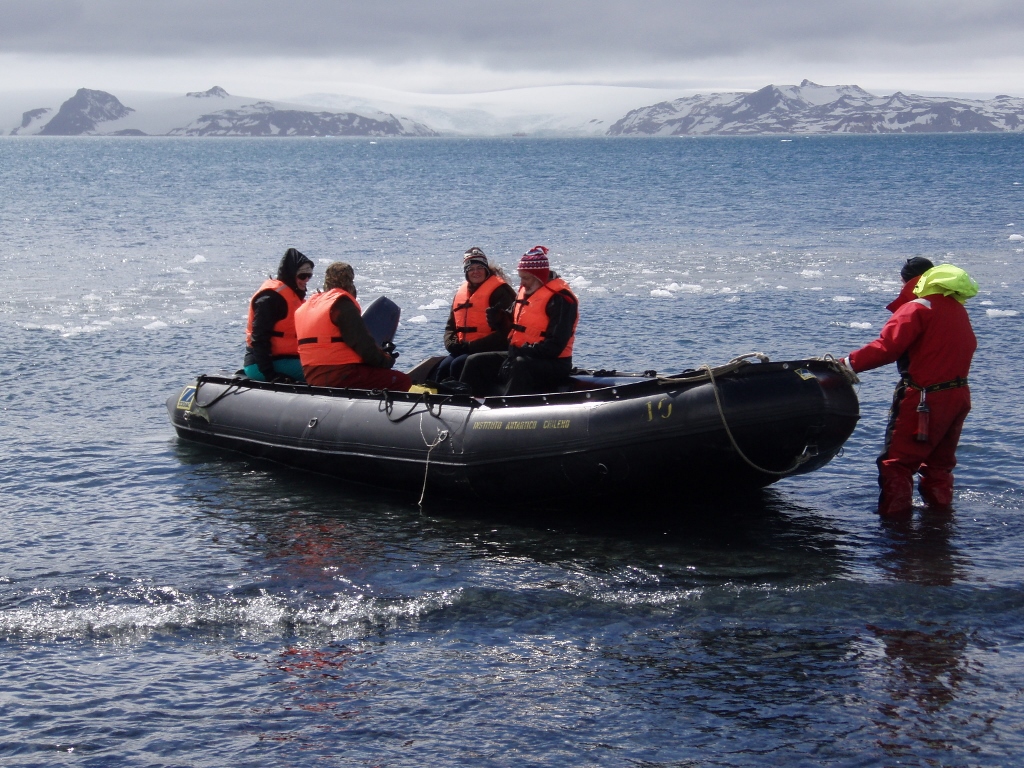 The boat and passengers equipped for a sunny-day tour
The boat and passengers equipped for a sunny-day tour
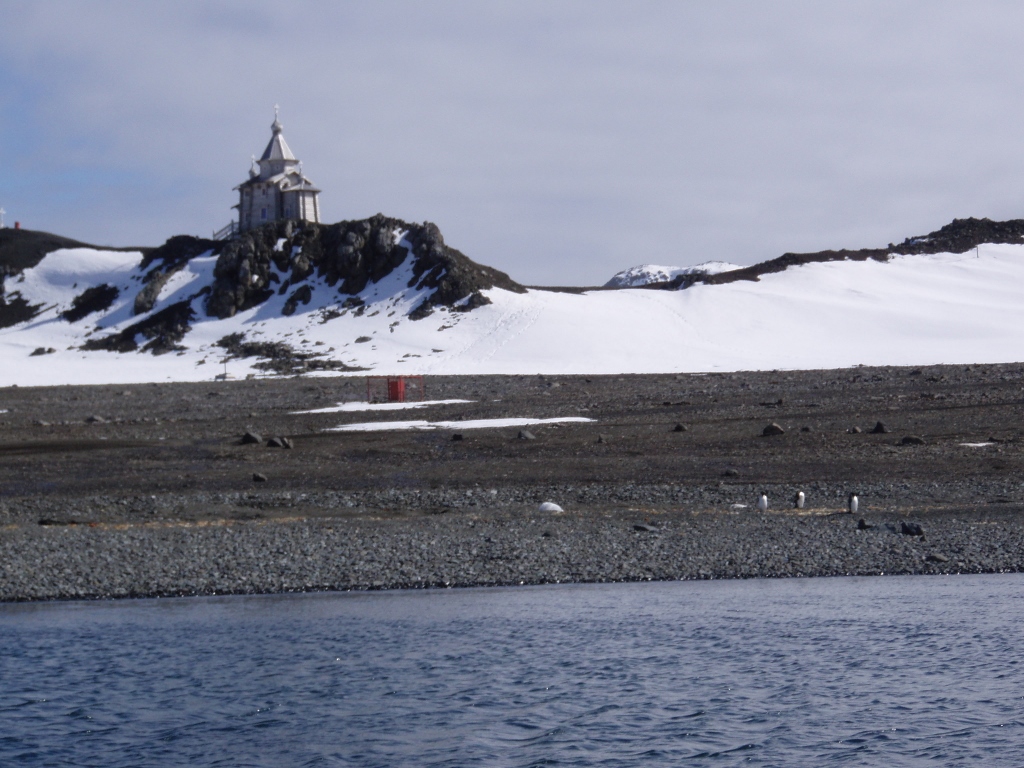 We are going for a ride around the island while the penguins are waving to us from the beach
We are going for a ride around the island while the penguins are waving to us from the beach
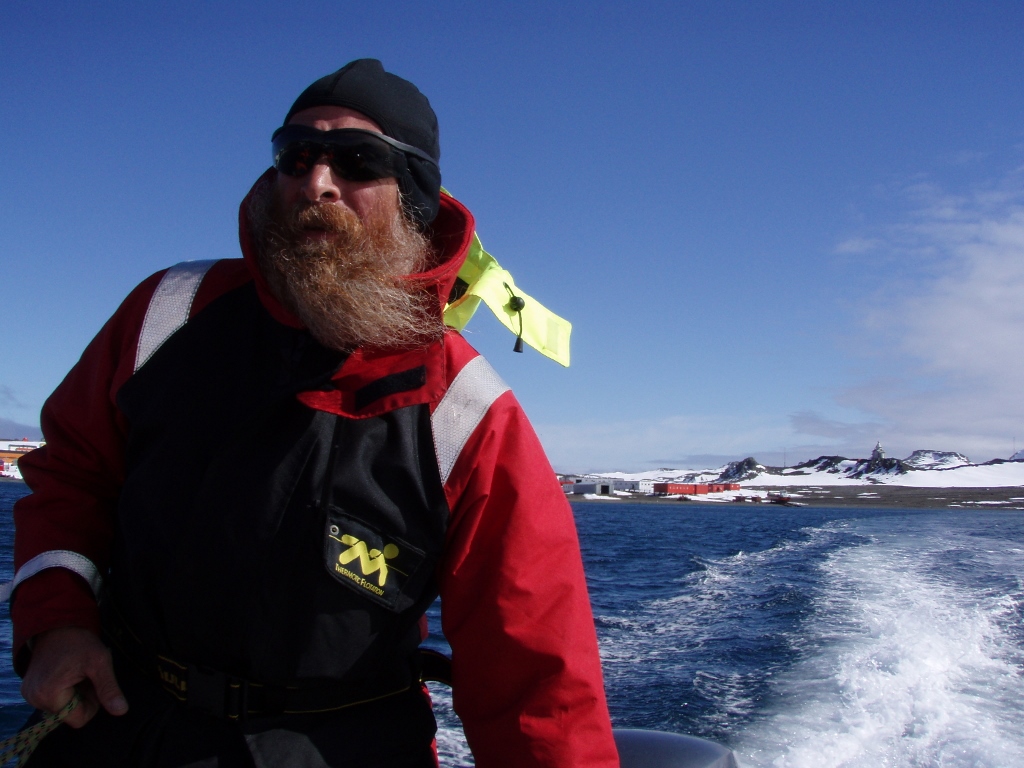 Alejo, the guide
Alejo, the guide
First we went to a beach not far away that was full of penguins. As we approached the shore, we could also see penguins on the top of a nearby steep hill. Along the shore there were places where they nested and some of the penguins kept sitting on their eggs without moving despite our presence when taking photos of them – albeit from a reasonable distance.
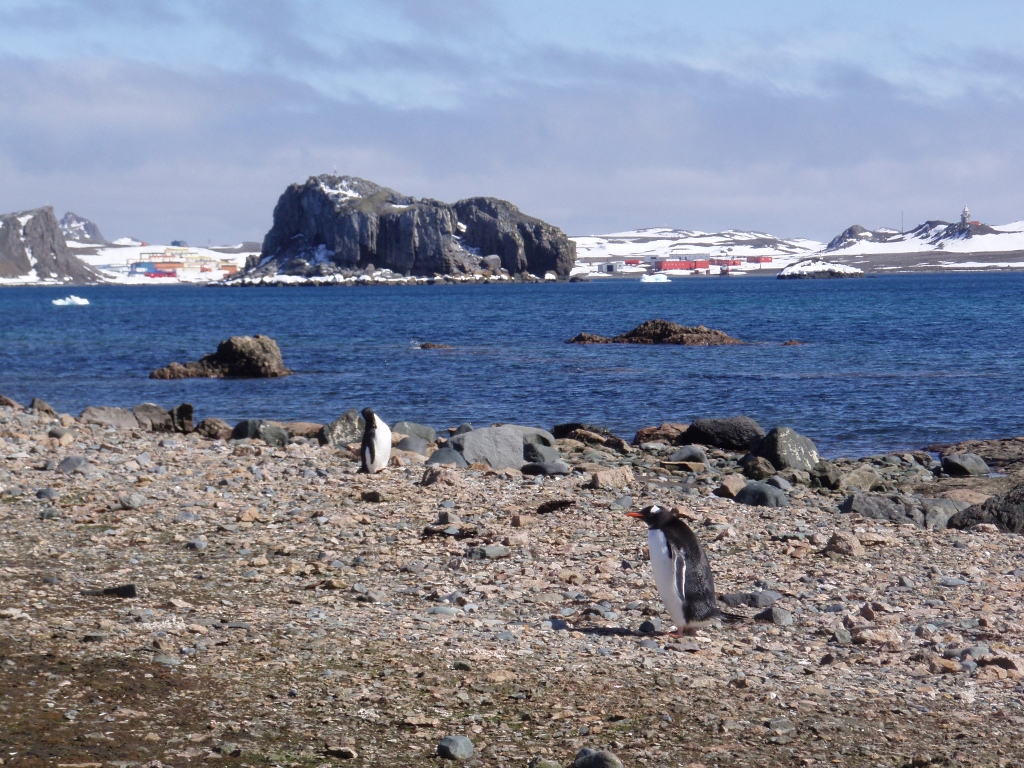 Penguins on the shore; the Chilean and the Russian bases may be seen in the distance
Penguins on the shore; the Chilean and the Russian bases may be seen in the distance
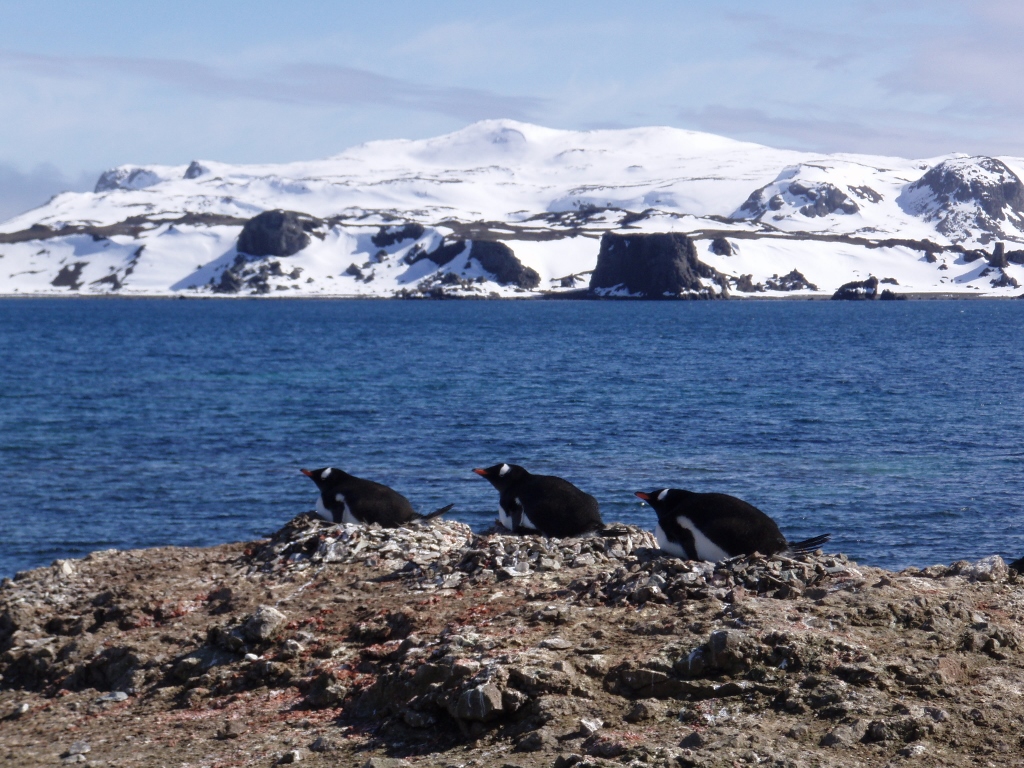 Penguins sitting on their nests
Penguins sitting on their nests
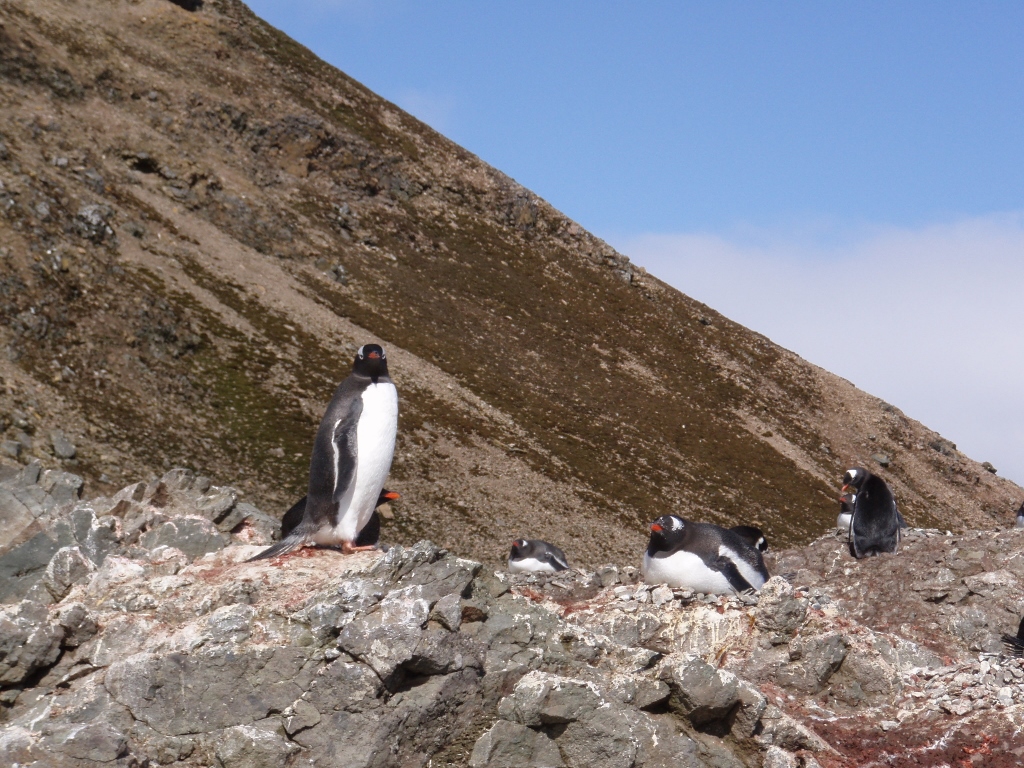 Penguins sitting on their nests and the “guards”
Penguins sitting on their nests and the “guards”
At first, we saw only one type of penguins and these were gentoo penguins (white patch above the eye and a red beak), but then adelie penguins (completely black head and a dark, small beak) started to appear, as well as chinstrap penguins (with a clearly visible line that goes from one “ear” to the other across the chin).
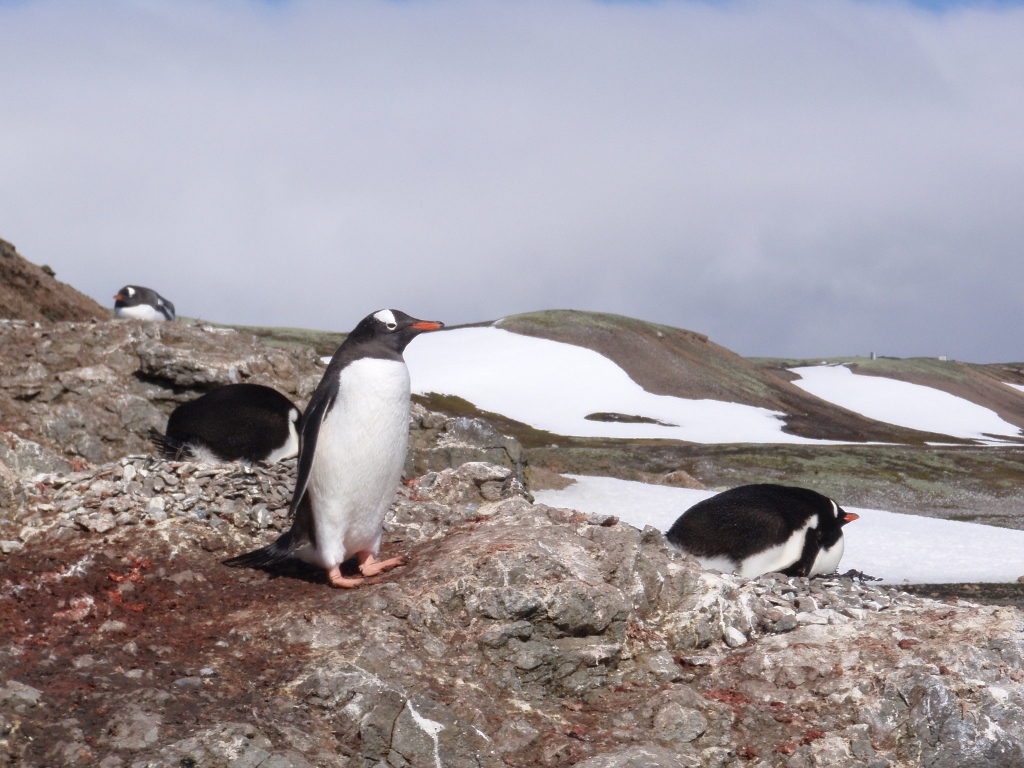 Gentoo penguins
Gentoo penguins
There we sat for a while on the rocky beach and as it turned out the stones were unexpectedly even warm. We hoped that penguins would want to come closer to us and look at those strange beings that do not wobble when they walk. That sitting still also gave us an opportunity to observe the penguins that had just gotten out of water and that first had to arrange their feathers. Some of them were coming down the hill and some others were going up.
It was nice sitting there close to them, but despite the half an hour stay or so on the beach, this was still too little. I realized that I enjoyed it very much if I could just sit and quietly observe animals. Unfortunately, most often this is not possible.
We got into the boat again and at rather fast speed we went to see a glacier. This thing about the speed was important, since the “wind” created in this manner really blew us to the bones. When we got to a place where a huge glacier “runs” into the sea, Alejo first slowed down and then he stopped the engine altogether so that we could admire this fantastic pile of ice and enjoy the quiet and calm scenery around us. The size of the glacier we could see there was really impressive. It appeared like a huge slope covered in snow, but this was all in fact pure ice.
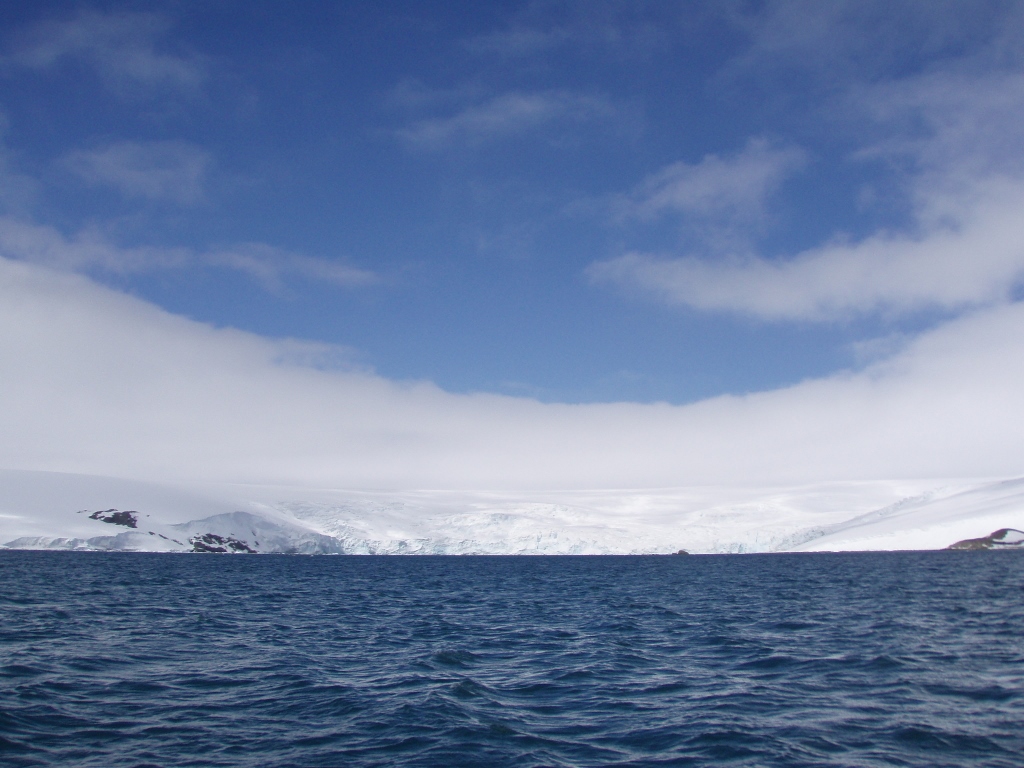 Approaching the glacier on Saint George island
Approaching the glacier on Saint George island
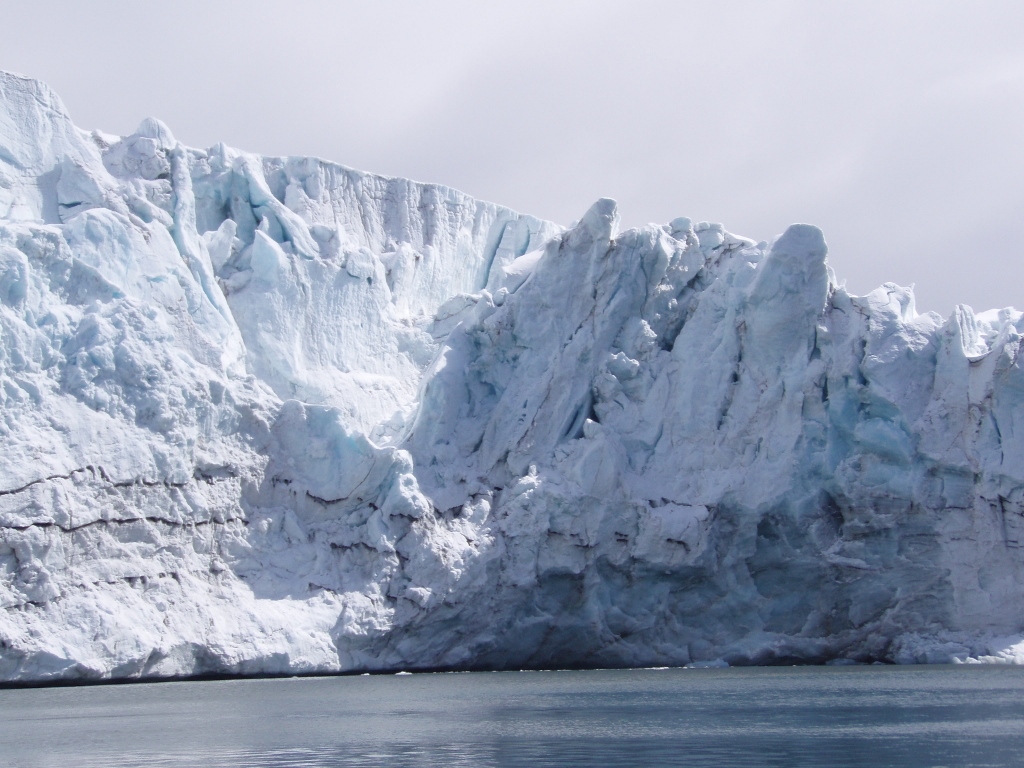 The glacier on Saint George island from up close
The glacier on Saint George island from up close
It is interesting that it is possible to see thin layers of soil in the glacier. A few years later, a paleontologist I met told me that while moving, a glacier occasionally comes across ground and slips over it, picking up the soil and then over time this soil appears as a layer.
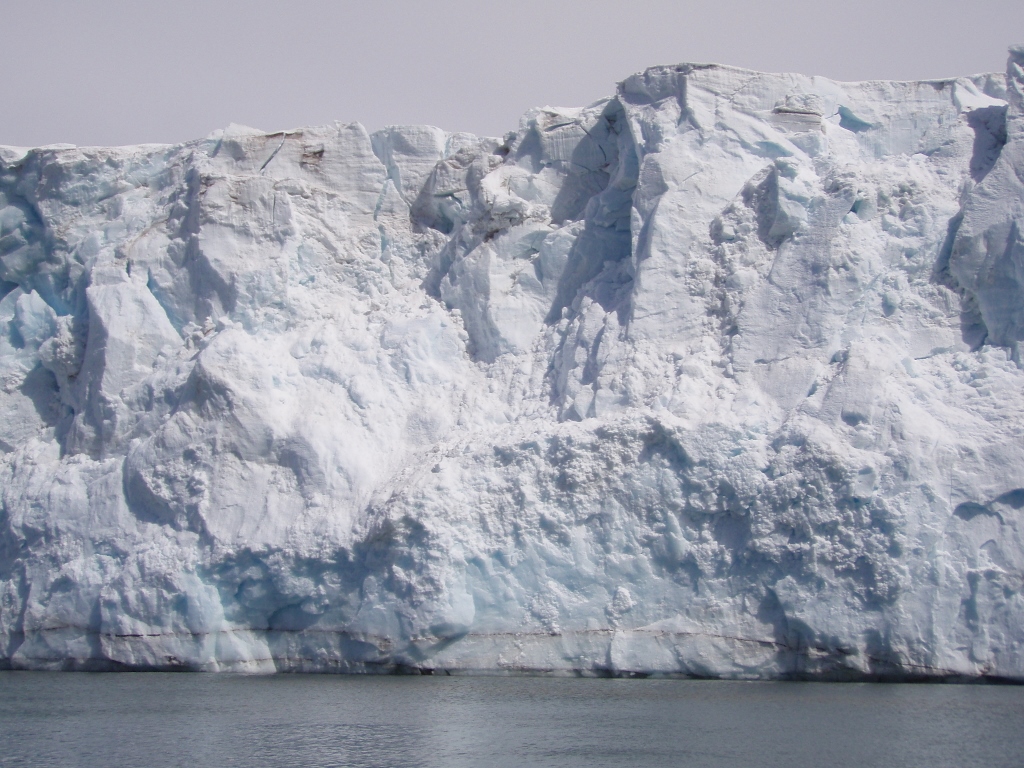 The glacier on Saint George island from up close
The glacier on Saint George island from up close
We could not approach the glacier too closely in our rubber boat for fear that a large chunk of ice could fall off. The wave this would create could turn over our boat or at least project one of us into the water. In this cold water, unless one dies of a heart attack or a shock, one can survive for 15 minutes maximum, unless you are duly prepared and dressed in appropriate thermal clothes. But, for us, dressed in dry ordinary clothes, the scenery including smaller icebergs and pieces of ice floating around us was absolutely fantastic.
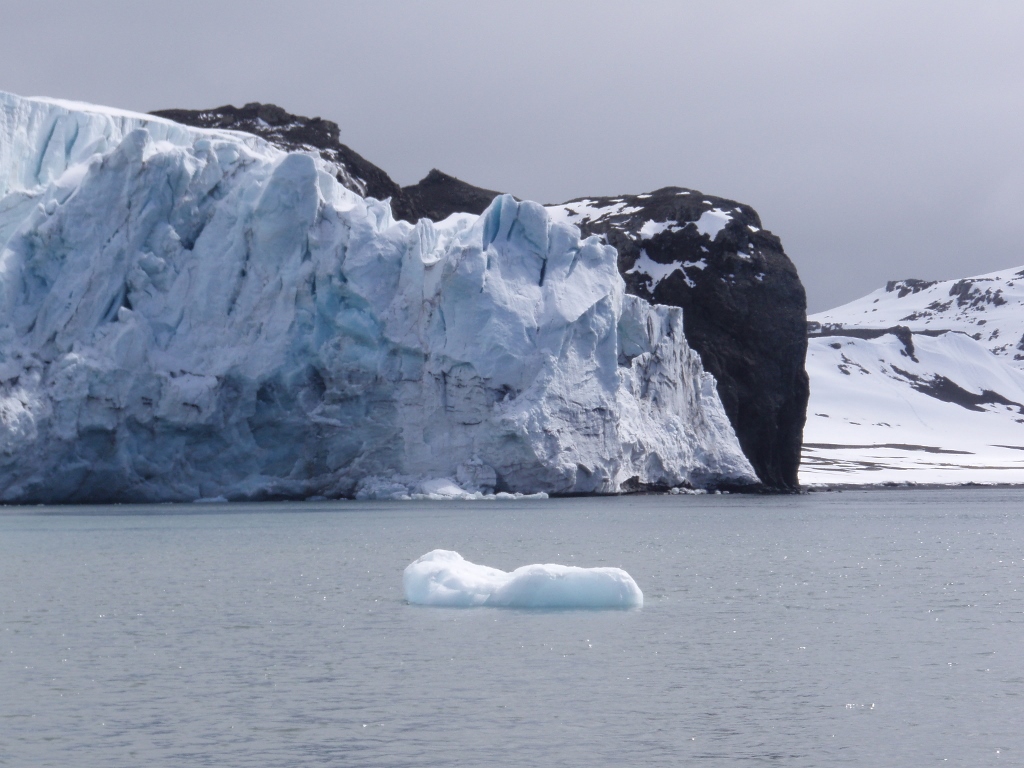 The glacier on Saint George island and a small iceberg
The glacier on Saint George island and a small iceberg
Here we stayed for a while, since Alejo hoped we may see a leopard seal, the biggest predator in the neighbourhood, which has a habit of getting out onto an iceberg and rest there, but we were not that lucky.
As we didn’t see leopard seals, we sent to a dock where we disembarked and first visited a nearby research camp of a British geological expedition, but the members were obviously all out in the field and the camp was vacant. Their central station was some 500 km away. For their stay here they used some special, Scottish-made tents which Alejo praised as exceptionally well constructed, for they cannot be toppled, they have some kind of movable floor and what not, in addition to which they were particularly good for snow and cold.
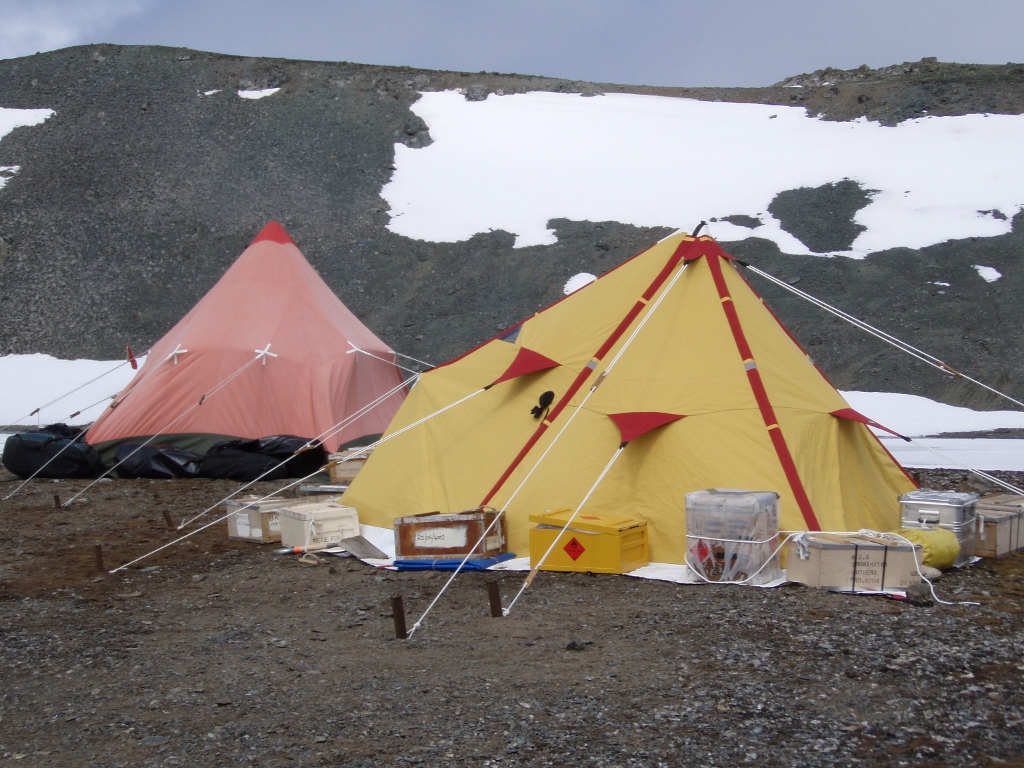 British research camp
British research camp
On our way to the camp and coming back, we crossed over some parts where dense moss completely covered and filled up the space between stones. Walking over the moss was exceptionally pleasant, for it felt softer than the softest carpet.
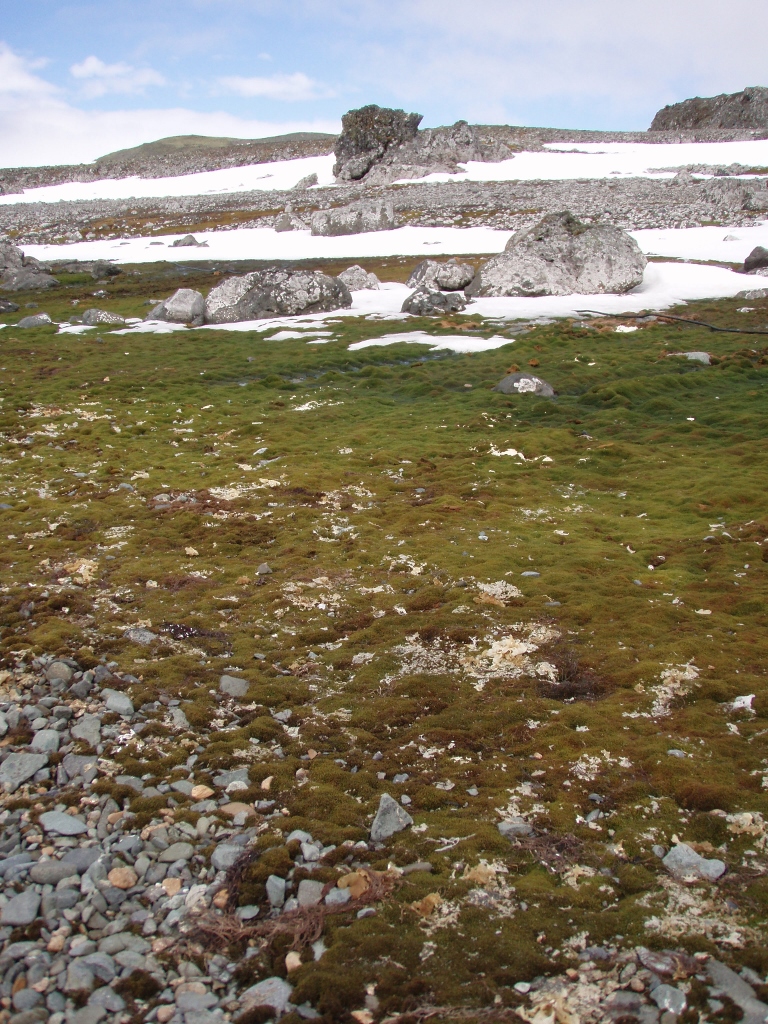 The moss
The moss
The pier at which the boat stopped was actually intended for the needs of the Great Wall Station, which, of course, was Chinese. We went to visit them as well and there we saw a souvenir shop, but we also had our passports stamped, as that is one of the most interesting reminders of this visit.
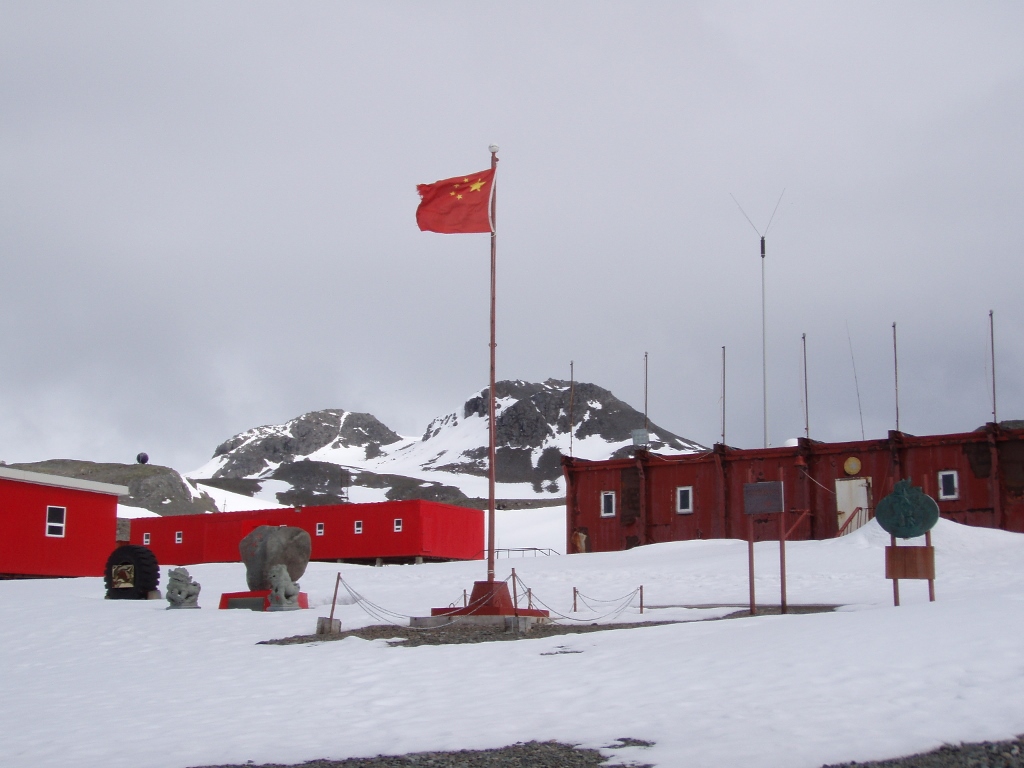 The Great Wall Station
The Great Wall Station
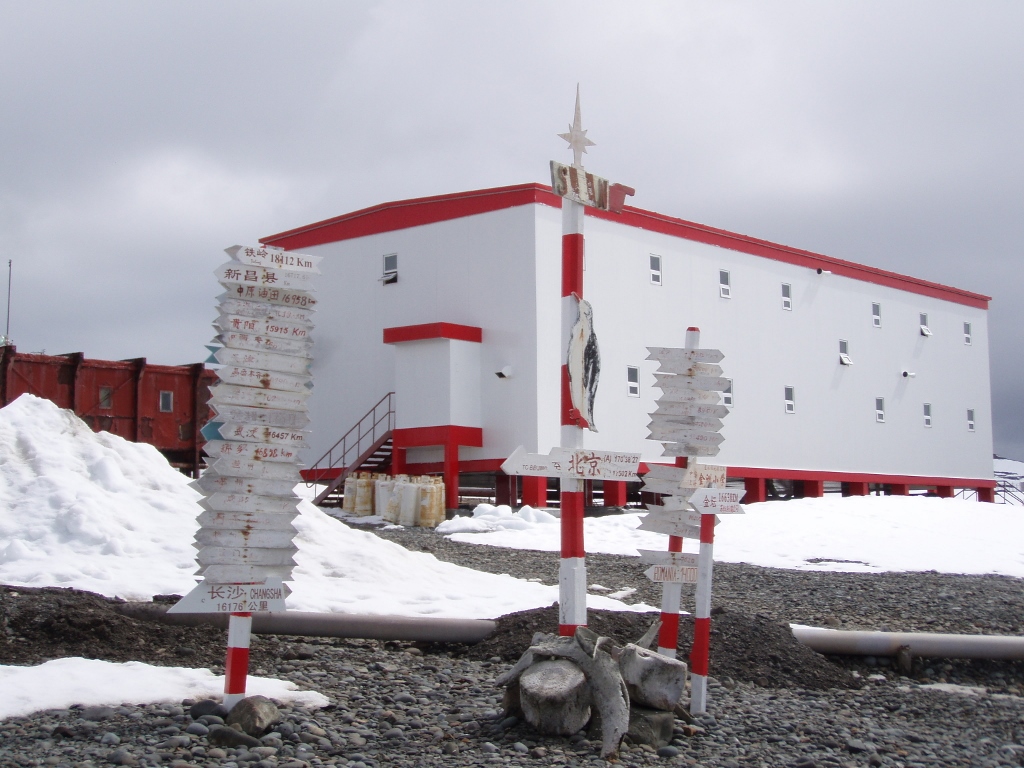 The Great Wall Station
The Great Wall Station
After all these visits, we got into the boat again and went to the beach near the Russian base. There we encountered and greeted Sasha who was busy there working on a truck. Although it was not too cold, we found it odd that he was only in a shirt and an unbuttoned one at that! When we asked him about it, he said he came from the Ural mountains and that it was often minus 30 there, so he found this temperature quite pleasant.
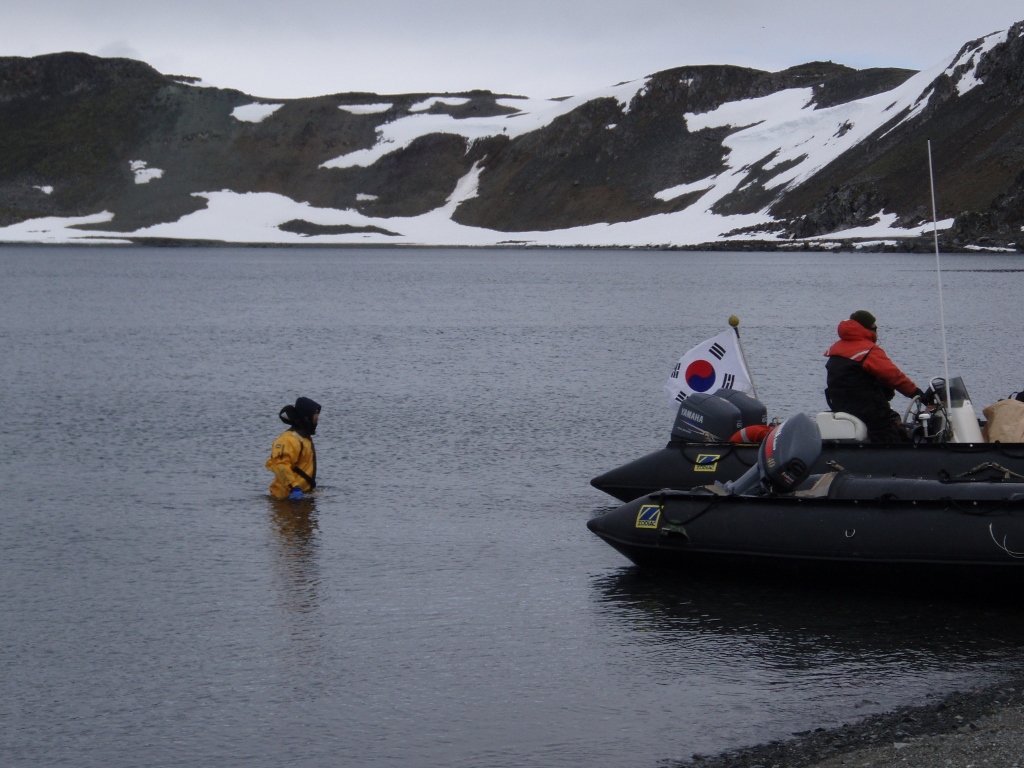 Korean boat and a man in special thermal clothes
Korean boat and a man in special thermal clothes
Then we went to the Russian offices where we also had our passports stamped, and Sneza and I had a chat with a biologist who had come there for some researches, but he obviously had a lot of free time and was working on a huge puzzle laid across a big table telling us that he wanted to die of boredom.
And this was when the time for our return to the continent came really close. First we walked over to our “living room” leaving there our sleeping bags and the things we brought from the “room” – the container. Then we went to a local post office where we bought and sent some postcards, and we also checked out a souvenir shop. A short stroll around the Chilean base and that was it. Then we all headed for the airport.
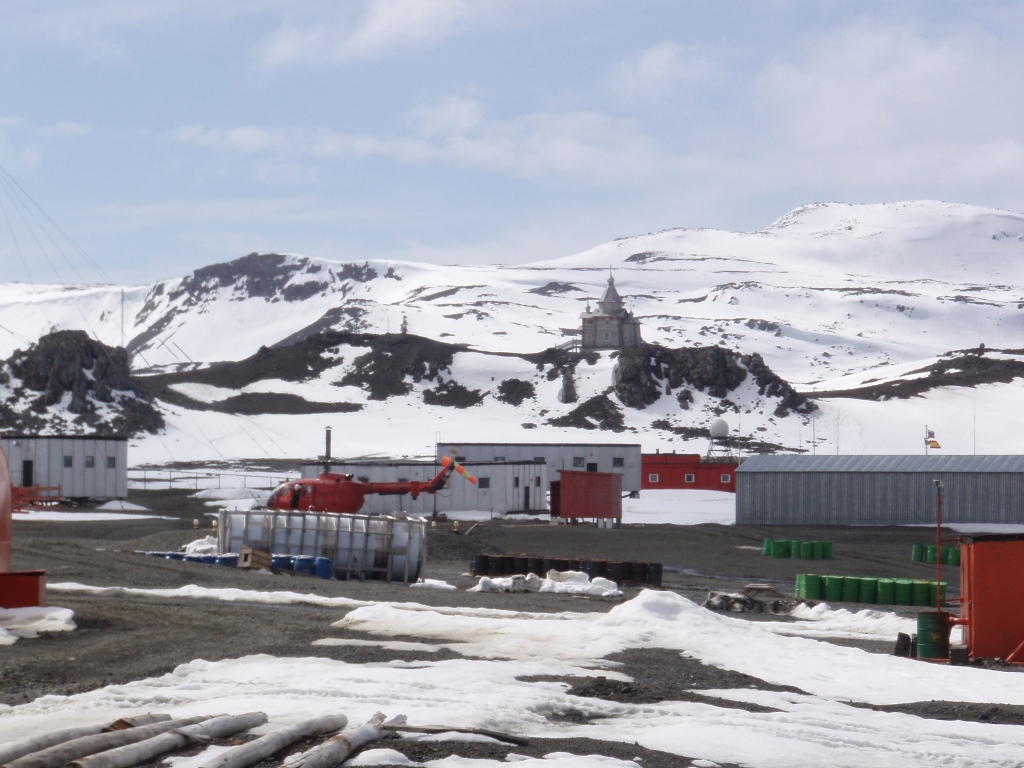 Another view at the Bellingshausen Station
Another view at the Bellingshausen Station
The flight was leaving around 3.30 in the afternoon and I really felt very sad. It just felt too short, although I didn’t know what else there would be for me to do. I had seen more or less everything there was to see, but the place was truly fabulous and attractive. I didn’t know if it was all about the very notion that I was in Antarctica or about some special energy or I was truly attracted by such a place with all of its elements – animals and the exotic aspect of a far away and rarely visited destination.
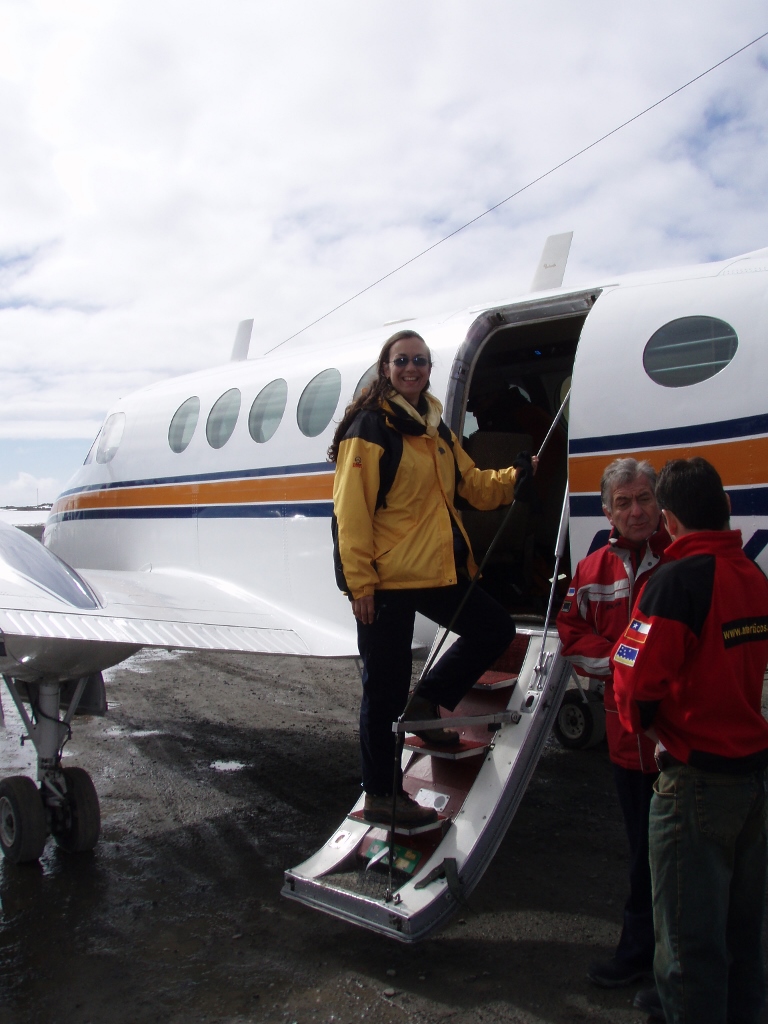 Entering the plane
Entering the plane
We took off in great weather. For a while, the pilot flew very low and when we passed by a large iceberg, the plane then went up and took us over to Punta Arenas.
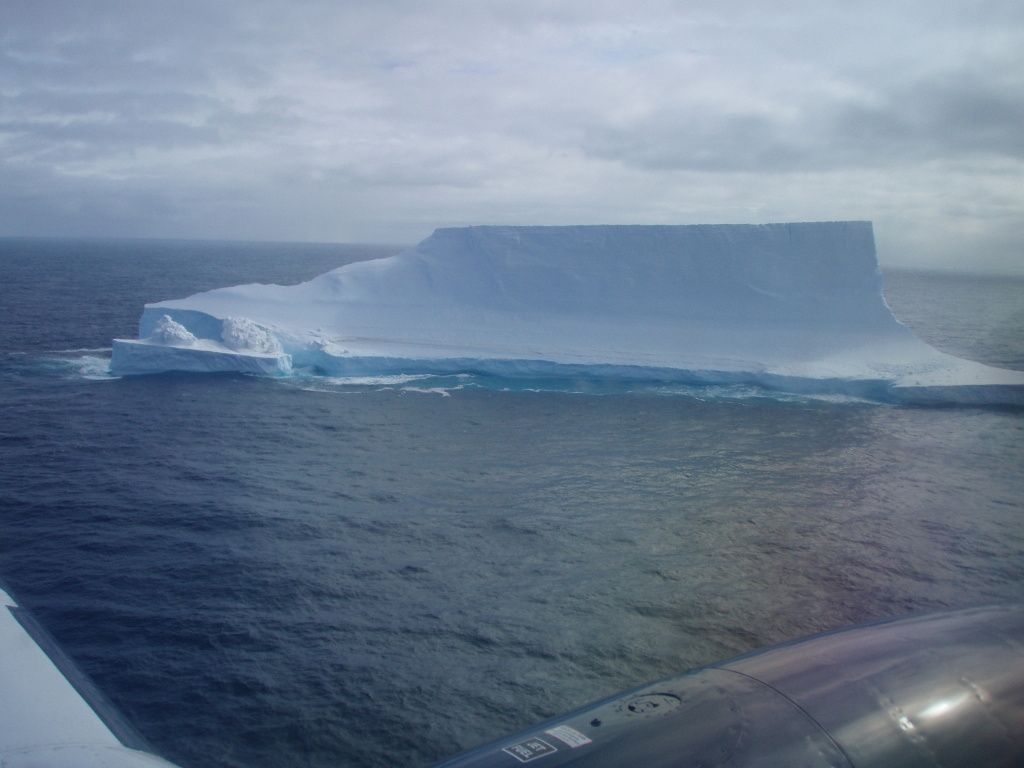 Flight above an iceberg
Flight above an iceberg
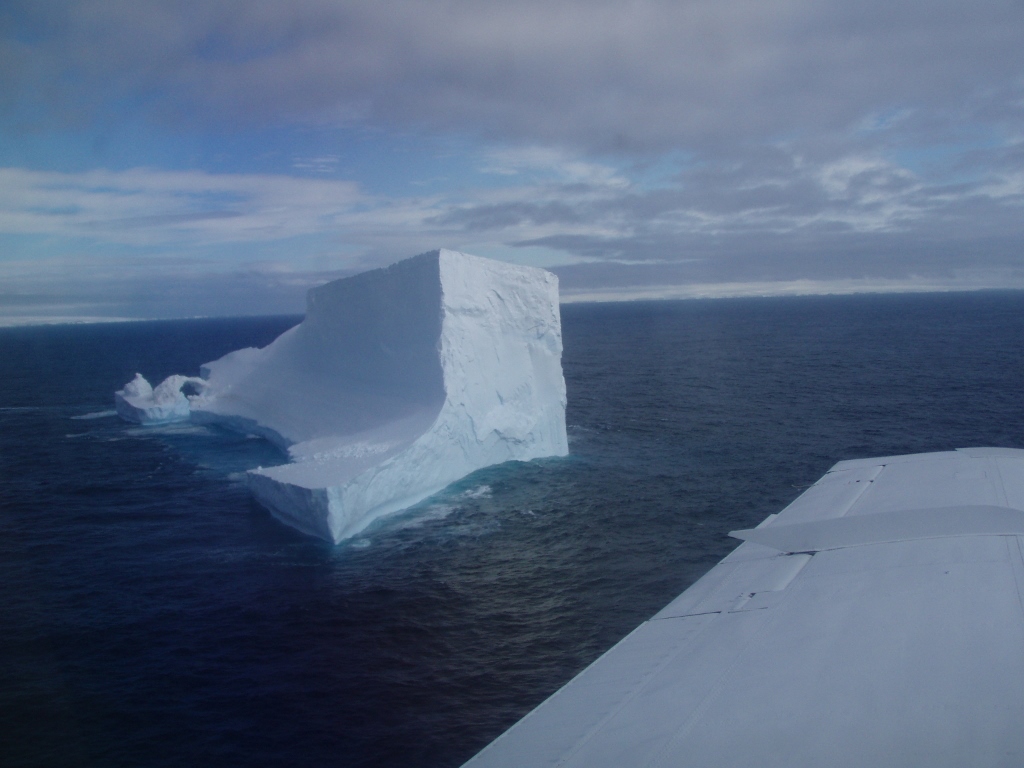 Flight above an iceberg
Flight above an iceberg
The return flight took slightly longer than the first one, but it was quite comfortable. I even managed to sleep for an hour despite the noise and the narrow seat. I was deeply impressed by myself. The previous night I had practically slept for only two and a half hours and yet I didn’t feel tired at all until I had relaxed on the plane.
When we landed in Punta Arenas and came to the airport building we started to say good-bye one to the other, since we had just shared a very specific, some 30 hour long adventure together. Only the elderly gentleman, the “Pilot,” who was so tiresome most of the time and to whom I tied his cap in Antarctica as he was unable, owing to his age and uncertain fingers, and as I have understanding for the elderly, turned away and without a single word to anyone headed towards the exit. I commented this to Sneza and although this was done in Serbian, the essence of my comment did not escape the “Lawyer” and his wife. When it was our turn to bid farewell, the Lawyer said to me: “I apologize for my compatriot. Not all the Americans are the same.” I smiled at him and full of understanding said: “It is all right. Neither are all the Serbs.” And with this we finally parted.